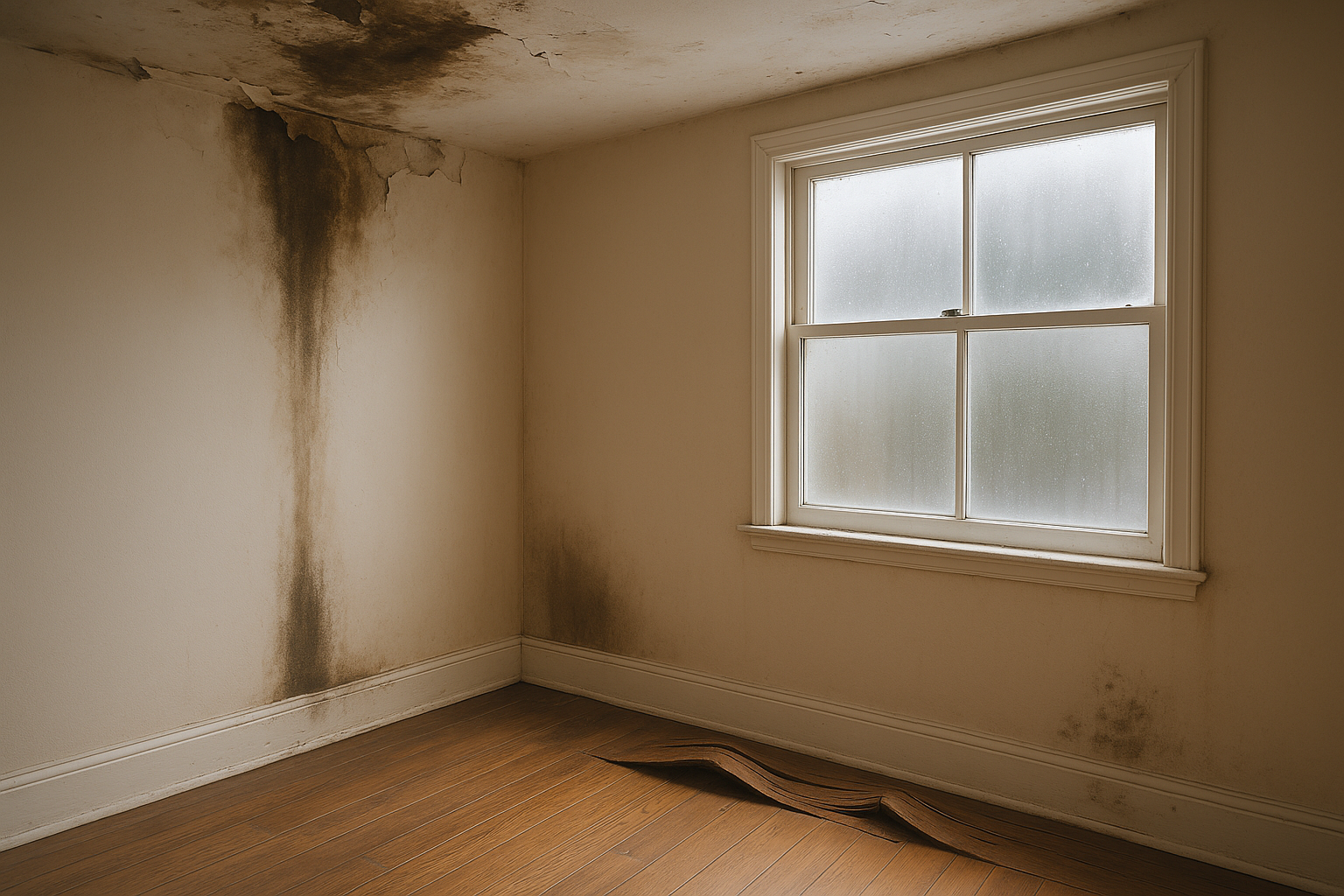Moisture ruins homes quietly. In Flagstaff, water gets inside through cracks, roofs, and basements before anyone notices. By the time stains or warped floors show up, repairs are already costly. Most people miss the early signs. That’s why inspections matter.

What Moisture Leaves Behind
Walk into a room and catch a musty smell. That’s not just old air; it’s a sign water has been sitting somewhere it shouldn’t. Dark stains creep across ceilings and down walls. Baseboards swell and paint peels away in strips. Floors start to warp, boards lifting at the edges or buckling in the middle. Windows fog up from the inside, and condensation pools on cold surfaces. Mold shows up in corners or behind furniture, sometimes hidden until you move something out of the way.
- Dark stains on ceilings, walls, or baseboards
- Musty, damp odors in basements or crawl spaces
- Floors that buckle, swell, or feel soft underfoot
- Condensation on windows, especially in the morning
- Paint or wallpaper peeling away from the wall
- Mold patches in corners, closets, or behind furniture
Each of these signs points to water working its way through the house. Mold doesn’t wait. It grows fast, especially in hidden spots. When you spot any of these, it’s time to bring in certified mold inspection professionals who know where to look and what to do next.
Where Moisture Hides
Flagstaff’s weather puts homes to the test. Freeze-thaw cycles crack foundations and open up tiny gaps around windows and doors. Water slips in, then freezes and expands, making the cracks worse. Roofs take a beating from snow and sun, and any weak spot becomes a path for leaks. Attics trap moisture if ventilation isn’t right, and that’s where rot and mold get started. Basements and crawl spaces collect water from the ground, especially after heavy rain or snowmelt. Even a small leak can soak insulation, rot wood, and invite pests.
- Foundation walls: cracks, damp spots, or white mineral stains
- Window and door seals: soft wood, peeling caulk, or drafts
- Roof penetrations: around chimneys, vents, and skylights
- Attics: wet insulation, dark spots on rafters, or poor airflow
- Basements: standing water, rust on metal, or musty air
Every inspection covers these problem areas. A close look at foundation walls reveals cracks and dampness that most people miss. Window seals and roof edges get special attention. Through our attic inspection process, we check for blocked vents and hidden leaks before they turn into major repairs.
Tools That Find What Eyes Can’t See
Some damage hides behind fresh paint or under new flooring. That’s where experience and the right equipment make the difference. Moisture meters go straight to the source, measuring dampness inside walls and under floors. Thermal imaging cameras spot cold, wet areas that never show up in a regular walk-through. These tools reveal leaks, trapped water, and hidden mold before they become obvious, or expensive.
During a water damage assessment, every part of the home gets checked. Gutters and downspouts get a close look for clogs or leaks. Drainage around the house is tested to see if water is pooling near the foundation. Entry points, like where pipes or wires come through walls, are checked for gaps. Indoor humidity is measured, because high levels feed mold growth concerns even when there’s no visible water.
- Moisture meters: find damp spots inside walls and floors
- Thermal imaging: shows cold, wet areas invisible to the eye
- Drainage checks: look for water pooling near the house
- Humidity readings: spot conditions that let mold thrive
Why Early Detection Saves Money
Water doesn’t fix itself. Left alone, it spreads. Wood rots. Drywall crumbles. Mold takes over. Repairs get bigger and more expensive with every week that passes. Catching moisture early means smaller fixes, such as patching a leak, drying out a wall, or sealing a window. Wait too long, and you’re looking at tearing out walls, replacing floors, or rebuilding parts of the foundation. Insurance rarely covers slow leaks or long-term damage. The cost lands on the homeowner.
Flagstaff homes face more moisture threats than most. Snow piles up, melts, and seeps into basements. Summer storms dump water faster than the ground can handle. Temperature swings open up cracks and let water in. Every year, homes that looked fine in the fall show damage by spring. Early detection isn’t just smart; it’s the only way to keep repair bills under control.
Schedule Your Moisture Inspection Today
Don't wait for visible damage to appear. Contact Aspen Home Inspections at 928-600-7761 or schedule your inspection online to protect your Flagstaff home from moisture damage.


